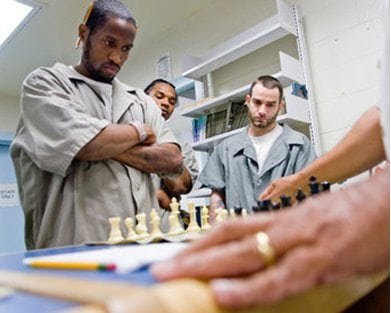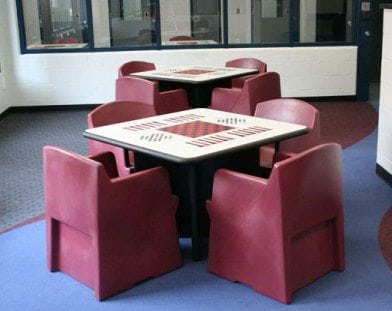Inmate Violence is Reduced with Chess-In-Jail Programs
Advocates Say Chess-In-Jails Programs Help Reduce Inmate Violence and Teach Good Decision-Making Skills
It was reported in April of this year that the Cook County Jail in Chicago, one of the largest single-site jails in the country, had implemented a chess-in-jail program at the facility as a way to get inmates to focus on learning and keep them occupied in an activity that is calming, yet engaging. It is thought to be the first program of its kind in the nation.
Chess champions and educators advocate chess programs in prisons and jails citing examples from Russia and Brazil where such programs have existed for years. Proponents of the program say the game helps inmates learn how to think analytically and have more impulse control.
 The Illinois Chess Association reported that playing chess in prisons was the topic of a presentation made at a conference on Chess and Education in Dallas, Texas, in November 2011. Professor Charles Moura Netto spoke on the development of cognitive and social skills that can be stimulated by chess outside a formal educational setting. He spoke about the Brazilian experience of teaching chess in prison in a project called Chess That Brings Freedom. Many of the prisoners are there for non-violent crimes and for being associated with the illegal drug business. The program has worked to rehabilitate prisoners through chess. They bring in local chess experts to teach the prisoners and reported that there is a reduction of violence and a lower recidivism rate in the prisons.
The Illinois Chess Association reported that playing chess in prisons was the topic of a presentation made at a conference on Chess and Education in Dallas, Texas, in November 2011. Professor Charles Moura Netto spoke on the development of cognitive and social skills that can be stimulated by chess outside a formal educational setting. He spoke about the Brazilian experience of teaching chess in prison in a project called Chess That Brings Freedom. Many of the prisoners are there for non-violent crimes and for being associated with the illegal drug business. The program has worked to rehabilitate prisoners through chess. They bring in local chess experts to teach the prisoners and reported that there is a reduction of violence and a lower recidivism rate in the prisons.
Situated on 96 acres on Chicago’s southwest side, the Cook County Jail has an average daily population of 8,800 inmates, with over 85% being male and from urban areas. Most of them are pre-trial detainees who could not make bail or were designated as “no bond” by a judge*.
 Cook County Sheriff Tom Dart, whose department runs the pre-trial facility, announced the adoption of the chess program by Division 11 of Cook County jail in April of this year, after consulting Mikhail Korenman, a long time teacher of the game, whose chess club includes one of the sheriff’s children. Korenman, a member of the United States Chess Federation Council is credited with coming up with the idea.
Cook County Sheriff Tom Dart, whose department runs the pre-trial facility, announced the adoption of the chess program by Division 11 of Cook County jail in April of this year, after consulting Mikhail Korenman, a long time teacher of the game, whose chess club includes one of the sheriff’s children. Korenman, a member of the United States Chess Federation Council is credited with coming up with the idea.
In an Associated Press article, Dart said that he hopes inmates can take what they learn from a game that rewards patience and problem solving, and apply it to their own lives. “We see it day-in and day-out that people want instant gratification and that often individuals do not think before they act. Thoughtless actions will hurt you while playing chess and hurt you more on the street.” Dart’s office said that 150 inmates are participating in the program.
 Also on hand for the announcement was Anatoly Karpov, a Russian chess grandmaster who was in the Chicago area promoting his Chess for Peace and Chess in Schools initiatives. According to the Illinois Chess Association, Karpov was impressed by the inmate-players and said some of them are ready for tournament play.
Also on hand for the announcement was Anatoly Karpov, a Russian chess grandmaster who was in the Chicago area promoting his Chess for Peace and Chess in Schools initiatives. According to the Illinois Chess Association, Karpov was impressed by the inmate-players and said some of them are ready for tournament play.
“It helps kids and it should help the people in the prisons get back to a normal life, make good decisions,” Korenman said
*Population Dynamics and the Characteristics of Inmates in the Cook County Jail, February 2012
David E. Olson, Loyola University Chicago, and Sema Taheri
If you are looking to find various chess tables to house in your jail facility, view the Chess Leg Style Tables from Norix. For those who are currently building a facility, review the Design Considerations for New Correctional Facilities. It might help to have Chess-In-Jail programs in your planning process as you prepare your new facility.
Do you also find that inmate violence can be reduced with having chess-in-jail programs in your jail facility? Share your experiences in the comment box below and please use the bookmarking tools to pass along this post with others.